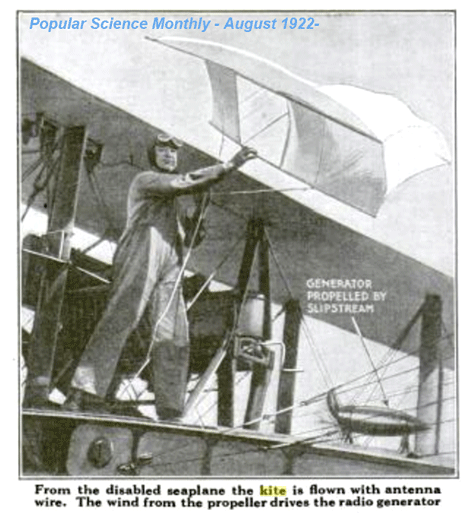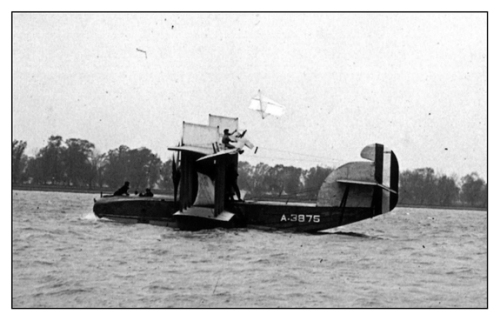Conyne Kites Used to Lift Radio Aerials to Assist Downed Seaplanes
During the early days of aviation the use of radio communication, also in its infancy, was dependent upon ideal conditions to get radio signals from the flying craft to land stations.
On August 27, 1910 Douglas McCurdy, flying an early Curtiss airplane, received what has been cited as the first wireless message sent to an aeroplane in flight, over Sheepshead Bay race track, New York1. Early wireless radio transmissions were of the Morse code variety adding to the complexity of the task of communicating between an airplane and the ground stations.
By 1917, the first air-to-ground and ground-to-air audio radio communications were accomplished by AT&T engineers working with the United States Army at Langley Field in Virginia. The experiments started on July 2nd and two way communication success was achieved by August 20, 1917.2
In all of the radio transmissions of this early era, lengthy aerials were trailed from the airplne in flight. These were spooled out after takeoff and wound in prior to landing. Later, by the early-1930's aerial wires were tautly strung from the fuselage behind the cockpit to the front of the rudder upright at the rear of the aircraft. Advances in wireless communication led to short mast aerials by late 1930.
During the 1920's seaplanes and 'flying boats'3 were often used for coastal patrols and other flights that took them over long stretches of water. Whenever a seaplane ran into engine trouble over water it could easily glide to a landing and very often there was no damage to the aircraft and no injury to the pilot and others aboard.
However, the prevalent radio communication of the day which employed the use of long trailing aerials was now useless with the seaplane on the surface of the water. This rendered radio communication impossible and left the downed pilots at the mercy of visual sightings by either search boats or rescue seaplanes.
To counter this loss of traditional radio contact by a downed seaplane, technical staff at the United States Navy Air Station Radio Laboratory in Anacostia D.C. came up with a pragmatic solution to the situation.
 Commander Taylor and Lieutenant C.D. Palmer experimented with raising an antenna from the downed aircraft with a Conyne kite and attaching it to the seaplane's radio system. With the elevation of the kite to 200-300 feet using a light wire flying line which served as the aerial, they were able to establish radio communications over long distances.4
Commander Taylor and Lieutenant C.D. Palmer experimented with raising an antenna from the downed aircraft with a Conyne kite and attaching it to the seaplane's radio system. With the elevation of the kite to 200-300 feet using a light wire flying line which served as the aerial, they were able to establish radio communications over long distances.4
Simple kits, weighing only a few ponds, were developed for all seaplanes to equip them with these emergency aerials. In each kit were 350 feet or aerial wire/flying line and two kites. The largest kite was seven feet tall for light winds and a slightly smaller kite was six feet tall for stronger winds.

This use of kites to raise aerials when downed airmen were in distress was a precursor to the later Gibson Girl radio rescue system. Developed in 1932 in Great Britain, the Gibson Girl array used an aerial raised by a box kite. It was deployed throughout the Second World War and beyond.
The above uses of kites as rescue devices were not the only types of kite rescue systems. In 1859 an Irish priest, Fr. E.J. Corner designed a kite rescue system to lift sailors to safety from vessels wrecked along the rocky coast of Ireland.
Even today, kites are still carried by people on expeditions and at sea as a system for attracting attention and facilitating a rescue. The latest such system is the Skystreme radar reflective location marker kite available from Skystreme UK Ltd, Middlesex, UK. This kite is Airtight and waterproof and constructed of metallised Mylar laminate. Light in weight, the Skystreme kite flies, floats and can self launch in winds as light as 4 mph. Requiring no power supply of any description, it is able to lift devices such as compatible high visibilty strobe lights and windsocks.
______________________________
Notes:
1. Douglas McCurdy, one of the members of Alexander Graham Bell's Aerial Experiment Association, went on to work as a pilot for Curtiss Aircraft in 1910. Prior to that he had been the lead engineer on the Aerodrome #4 project, the Silver Dart, and the pilot of the first aircraft to fly in the British Empire (The Silver Dart, Feb. 23, 1909 at Baddeck, Cape Breton Island, Nova Scotia. McCurdy and a partner Casey Baldwin, also a member of the AEA, formed the Canadian Aerodrome Company in late 1909. When the Canadian government chose not to buy any of the early aircraft models produced by that company, McCurdy went to work for Glenn H. Curtiss at the Curtiss Aircraft Company in Hammondsport, NY.
2. AT&T - 1st Air-to-Ground / Ground-to-Air Radio Communication.
3. Airplanes using floats were first developed in the United States by Glenn H. Curtiss of the Aerial Experiment Association (the "Loon", September 1908) and by engineer Henri Fabre ("Le Canard" March 1910).
4. "Disabled Planes Send 'SOS' With Kite Antenna." Popular Science Monthly, August 1922, page 40.
5. Image of twin engine flying boat deploying Conyne kite with aerial. Source: US Naval Institue Archives.





Reader Comments